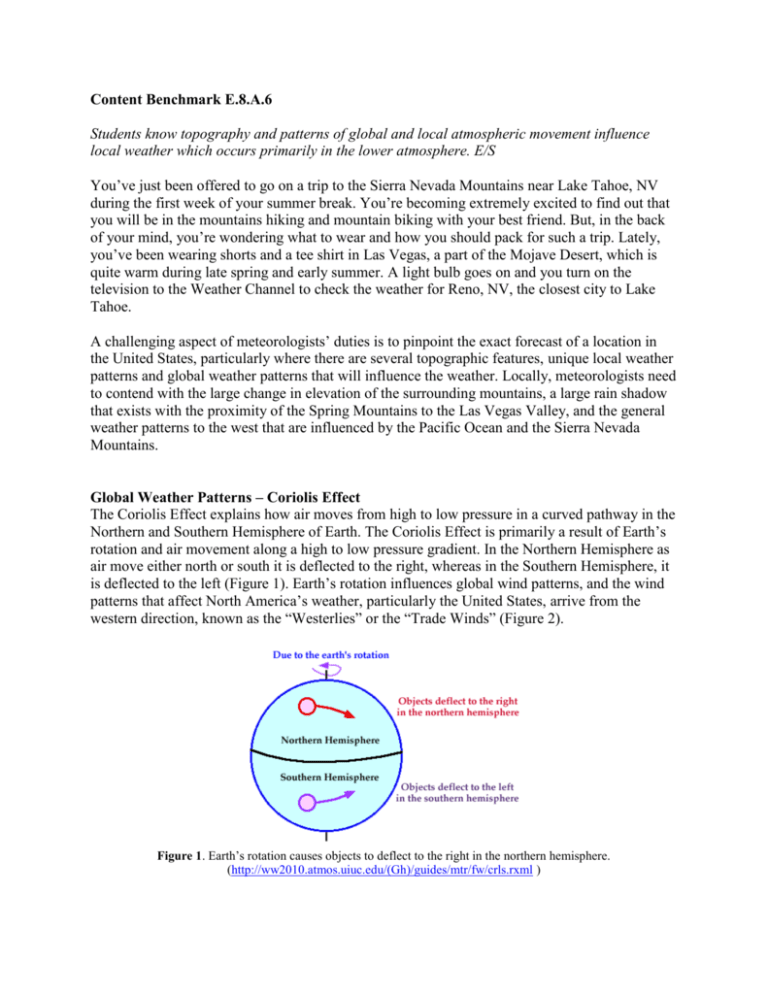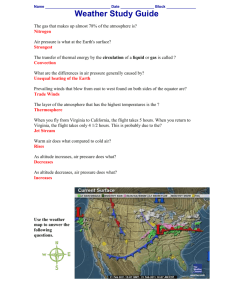E8A6_topography and weather_FinalS
advertisement

Content Benchmark E.8.A.6 Students know topography and patterns of global and local atmospheric movement influence local weather which occurs primarily in the lower atmosphere. E/S You’ve just been offered to go on a trip to the Sierra Nevada Mountains near Lake Tahoe, NV during the first week of your summer break. You’re becoming extremely excited to find out that you will be in the mountains hiking and mountain biking with your best friend. But, in the back of your mind, you’re wondering what to wear and how you should pack for such a trip. Lately, you’ve been wearing shorts and a tee shirt in Las Vegas, a part of the Mojave Desert, which is quite warm during late spring and early summer. A light bulb goes on and you turn on the television to the Weather Channel to check the weather for Reno, NV, the closest city to Lake Tahoe. A challenging aspect of meteorologists’ duties is to pinpoint the exact forecast of a location in the United States, particularly where there are several topographic features, unique local weather patterns and global weather patterns that will influence the weather. Locally, meteorologists need to contend with the large change in elevation of the surrounding mountains, a large rain shadow that exists with the proximity of the Spring Mountains to the Las Vegas Valley, and the general weather patterns to the west that are influenced by the Pacific Ocean and the Sierra Nevada Mountains. Global Weather Patterns – Coriolis Effect The Coriolis Effect explains how air moves from high to low pressure in a curved pathway in the Northern and Southern Hemisphere of Earth. The Coriolis Effect is primarily a result of Earth’s rotation and air movement along a high to low pressure gradient. In the Northern Hemisphere as air move either north or south it is deflected to the right, whereas in the Southern Hemisphere, it is deflected to the left (Figure 1). Earth’s rotation influences global wind patterns, and the wind patterns that affect North America’s weather, particularly the United States, arrive from the western direction, known as the “Westerlies” or the “Trade Winds” (Figure 2). Figure 1. Earth’s rotation causes objects to deflect to the right in the northern hemisphere. (http://ww2010.atmos.uiuc.edu/(Gh)/guides/mtr/fw/crls.rxml ) Figure 2. Wind Patterns on the globe are influenced by the Coriolis Effect. Most of North America is impacted by the Westerlies and the Trade Winds. (http://www.classzone.com/books/earth_science/terc/content/visualizations/es1905/es1905page01.cfm?chapter_no= 19) To view a video clip of students demonstrating the Coriolis Effect, go to http://weather.about.com/gi/dynamic/offsite.htm?zi=1/XJ&sdn=weather&cdn=education&tm=9 &f=00&tt=3&bt=0&bts=0&zu=http%3A//www.nasa.gov/audience/forstudents/brainbites/nonfla sh/bb_home_corioliseffect.html To learn more about the Coriolis Effect, go to http://ww2010.atmos.uiuc.edu/(Gh)/guides/mtr/fw/crls.rxml and http://www.classzone.com/books/earth_science/terc/content/visualizations/es1905/es1905page01 .cfm?chapter_no=19 Global Wind Patterns Planetary wind belts on Earth are a result of unequal heating of Earth, with the largest difference in heating occurring between the equator and the poles. Maximum insolation, also known as incoming solar radiation, occurs where the sun heats Earth’s surface at the equatorial belts causes warm air to rise in the atmosphere. At minimum insolation, where the sun heats Earth’s surface at the north and south poles cause cold air to sink. The general effect of this unequal heating is the circulation of air from the equator to the north and south poles. The equator is associated with low pressure zones due to the warm temperatures which allow warm air to rise, and the poles are associated with high pressure which cause cold air to sink. Specifically, air currents that rise from the equator (0 degrees latitude) sink at 30 degrees N and 30 degrees S latitude. This circulation pattern is due to the reduced amount of insolation at 30°N and 30°S latitude compared to the equator. Sinking air currents at 30°N and 30°S create a zone of high pressure at the latitude of 30 degrees. Air currents rise at 60°N and 60°S creating a zone of low pressure. Therefore a band of alternating low and high pressure belts exist on Earth’s surface. These bands of alternating pressure systems, in addition to the Coriolis Effect, create the planetary wind belts in which air moves from high pressure to low pressure. Figure 3.Global wind patterns of Earth. From (http://staffwww.fullcoll.edu/tmorris/elements_of_ecology/images/atmosphere_wind_patterns.jpg) Above, the global wind circulation diagram shows general patterns for surface winds. These winds are divided into three categories for both the Southern and Northern Hemisphere. Polar Easterlies moving from the east exist from 60° - 90° latitude. Prevailing Westerlies moving from the west exist from 30° - 60° latitude, which is known as the Westerlies. The third wind category is the tropical easterlies, which exist from 0° - 30° latitude, which are commonly known as the trade winds. To read more about global wind circulation, go to http://www.uwsp.edu/geo/faculty/ritter/geog101/textbook/circulation/global_scale_circulation.ht ml Air Masses Air masses are defined by the properties of temperature and moisture content within the body of air. Air masses are defined by where they originate. Terminology is provided that indicates the moisture, temperature and origination of the air mass. Origination terminology describes air masses, including: Continental (c); a dry air mass moving over land and Maritime (m) which describes a moist air mass moving over the ocean. Temperature terminology explains the temperature characteristics of the air mass. Arctic (A), Polar (P) and Tropical (T) indicate cold and warm temperatures, respectively. Combining these terms results in air mass terminology that describes the characteristics. Five basic air masses influence the United States weather, and include: Continental Arctic (cA), Continental Tropical (cT), Maritime Tropical (mT), Continental Polar (cP), and Maritime Polar (mP). For example, Continental Tropical (cT) describes, an air mass that originates in Mexico and moves through the Central US. The (cT) air mass has warm temperatures and dry air associated with this body of air. Maritime Polar, (mP), is an air mass that originates over the northern Pacific Ocean. It will bring low temperatures and high moisture content to an area. The diagram (Figure 4) below provides the locations of origination of these important air masses. Figure 4. Air masses influence the weather for North America. (http://earth.usc.edu/~stott/Catalina/images/weatherimages.jpg/airmasses.jpg ) To learn more about Air Masses, go to http://www.physicalgeography.net/fundamentals/7r.html Adiabatic Lapse Rate In the troposphere, the lowermost layer of the atmosphere, a relationship exists between two atmospheric properties, temperature and pressure, known as the adiabatic lapse rate. The adiabatic lapse rate explains how air temperature decreases as a parcel of air rises in the troposphere. The dry adiabatic lapse rate explains how a dry parcel of air will rise in the troposphere and will lose 5.5°F/1000 ft. (10°C/km) due to less air pressure exerting force on the parcel. The moist adiabatic lapse rate occurs when a saturated parcel of air rising in the troposphere loses 2-3°F/1000 feet (3-4.9°C/km). This occurrence in the troposphere creates weather patterns that can create different climates for regions that have mountains, lakes and coastal regions. Adiabatic Lapse Rate and Topography The topography of Nevada plays a large role in weather patterns. The mountains of Nevada cause the weather of high elevation areas to be different than the surrounding valleys. For example, Mt. Charleston, elevation 11,918 ft (3,633 m), has very different weather patterns than the Las Vegas Valley, which is approximately 2100 ft. (640m) above sea level. The large change in elevation causes a large change in temperature. In the case of Las Vegas Valley and Mt. Charleston, the lower valleys surrounding the Spring Mountains can be up to 35°F (19°C) warmer than the higher elevation mountains. The reason for the large temperature change is the result of adiabatic cooling. An air particle will travel almost 10,000 ft. (3,048m) and will drop close to 35°F (19°C), which can often create rain for the surrounding valley and snow for higher elevations. Orographic Precipitation Orographic precipitation occurs when an air mass is lifted and cooled as it moves over a mountain range. When the air mass cools the air becomes saturated with moisture and often precipitates in the form of snow, sleet, hail, or rain. Hawaii, Japan, the Philippines, and other mountainous islands are common areas for orographic precipitation to occur due to available moisture and large change in elevation. The western slope of the Sierra Nevada Mountains and the Rocky Mountains often experience orographic precipitation too. Figure 5. Orographic precipitation occurs as a warm air mass rises as it moves over a mountain causing precipitation to fall on the windward side of a mountain. (From: http://z.about.com/d/weather/1/0/X/2/-/-/orographic-lift.jpg ) Rainshadow Rainshadows are the dry region behind a mountain with respect to prevailing winds. Rainshadows are a primary result of orographic lift, the movement of moist air ascending a mountain creating clouds and precipitation. As orographic lift causes an air mass to rise and precipitate rain or snow, the moisture content in the air mass decreases. The resulting dry air mass descends down the leeward side of the mountain. In the United States, including Nevada, the prevailing winds move in the easterly direction. The Spring Mountains, including Mount Charleston, are in the westerly direction of the Las Vegas Valley, creating a rainshadow effect for the Las Vegas Valley. Rainshadows exist in other areas of the United States, including the Sierra Nevada Mountains, the Cascade Range, and the Rocky Mountains. Figure 6. A mountain intercepts moisture from large bodies of water. The leeward side of the mountain remains dry while the peak of the mountain experiences snow and rain. (from http://staffwww.fullcoll.edu/tmorris/elements_of_ecology/images/rain_shadow.jpg) To learn more about elevation and temperature change, go to http://www.classzone.com/books/earth_science/terc/content/investigations/es1706/es1706page03 .cfm?chapter_no=investigation Lake Effect Snow Topography plays a large role in the winter weather of the Great Lake States in the form of Lake Effect snow. The Great Lakes adjacent to states, such as Michigan, Ohio and New York create winter storms that have the potential to drop significant amounts of precipitation. Other areas of the United States and the world experience Lake Effect snow events, which include; parts of Canada adjacent to the Great Lakes, the Great Salt Lake, and places near oceans such as Nova Scotia, Canada and Chesapeake Bay, VA. The Lake Effect snow is a result of a cold air mass moving over a comparatively warm body of water. The warm “lake” water evaporates and rises, providing a significant amount of moisture to the air mass. When the cold air mass moves over a higher topography, such as the Western New York’s Allegany Plateau, the clouds precipitate, typically in the form of snow. The Lake effect often continues year round when rain falls over the regions, which requires a warm air mass to move over warm lake. Figure 7. Lake effect precipitation occurs when warm water evaporates and condenses as a cold air mass moves over land. (From www.weatherquestions.com/lake_effect_snow.jpg ) To read more about Lake Effect weather, go to http://www-das.uwyo.edu/~geerts/cwx/notes/chap10/lake_effect_snow.html Local Weather Patterns Within Nevada, and surrounding states in the Southwestern US, the weather can change dramatically from location to location. Weather factors that influence local weather patterns include: 1. Elevation, 2. Proximity to ocean and 3. Geographic location features Elevation Elevation plays a key role in temperature and precipitation patterns for a location. Generally, a lower elevation locality experiences warmer air temperatures compared to a higher elevation locality. This is primarily due to the adiabatic lapse rate of air parcels, among other weather factors. For example, Reno, NV, 4489 ft. (1,368 m) above sea level has an average annual temperature of 50.8°F (10.4°C), whereas Las Vegas, NV 2100 ft. (640m) above sea level has an average annual temperature of 67.1°F (19.8°C). Proximity to Ocean An area located near the ocean, such as San Francisco, CA will have different weather patterns than a city situated next to mountains like Reno or Las Vegas, NV, which are further away from the Pacific Ocean or other large body of water. An ocean will impact the weather for a location by increasing the relative humidity level providing an increase in available moisture for a weather system. In addition, a city located near a coastal range, such as Seattle, WA, is impacted by the rainshadow effect (see Rainshadows). Secondly, during the summer, an ocean can impact the air temperature of cities near oceans by maintaining comparably lower temperatures than inland locations, acting like an “air conditioner”. During winter, cities near oceans maintain relatively warmer temperatures than inland locations, thus acting like a “heater”. Sea and Land Breezes Sea and land breezes are a result of solar radiation heating land and water at different rates due to specific heat and air pressure differences. As the sun rises in the sky, it heats up water at a slower rate, while it heats the land at a faster rate. The difference in temperature of the warm land and cool water creates an air pressure difference, as a high pressure cell resides over the warm body of water and a low pressure cell is created over warm land. This difference in pressure creates a sea breeze moving from the ocean to land during the day. As the sunsets and solar radiation decreases, the land will cool down faster than the ocean. A low pressure cell develops over the warm ocean and a high pressure cell develops over the cooler land. The resulting wind moves in the direction from land to ocean at night. Figure 8. Sea and land breezes develop in regions that are adjacent to large bodies of water. (From http://www.tsvanguard.co.uk/images/land%20breeze.jpg ) To read more about sea and land breezes, go to http://www.ace.mmu.ac.uk/eae/Weather/Older/Sea_Breeze.html Content Benchmark E.8.A.6 Students know topography and patterns of global and local atmospheric movement influence local weather which occurs primarily in the lower atmosphere. E/S. Common misconceptions associated with this benchmark 1. Students may believe that the Southwestern US is dry and doesn’t receive any precipitation. Nevada, among the driest states in the US, does receive precipitation in all forms including rain, snow, sleet, freezing rain, and hail. In fact, records indicate from 1914 – 1956 Las Vegas, NV received on average 4.77 in. average annual precipitation. In the same time period from 1914 – 1956, Las Vegas has received 1.1 in. of annual average snowfall. In the time period from 1937 – 2005, Reno, NV has received 7.49 in. of average annual rainfall and 25.0 in. of average annual snowfall. To examine climate data for the Western US, including cities in NV, go to http://www.wrcc.dri.edu/index.html 2. Students incorrectly think that it can’t snow at lower elevations. Despite the low amounts of precipitation in the desert southwest, it snows in the desert, particularly in the Las Vegas Valley. Throughout the winter season, the Las Vegas Valley experiences cold air masses that can trigger precipitation if enough moisture is associated within the air mass. It is much more likely, for higher elevations to experience precipitation in Nevada due to orographic lift, the process of a warm air mass cooling down as it rises up the mountain slope it cools down and precipitates. To further examine the process of orographic lift and precipitation, go to http://ww2010.atmos.uiuc.edu/(Gh)/guides/mtr/cld/dvlp/org.rxml 3. Students incorrectly think that the Coriolis Effect impacts sinks and toilets. The Coriolis Effect is the deflection of winds, water currents and hurricane systems due to the rotation of Earth. Rather than winds moving in a straight line from high to low pressure, objects and air masses veer to the right in the Northern Hemisphere and they veer to the left in the Southern Hemisphere as they move in a northerly or southerly direction. The Coriolis Effect doesn’t impact toilets or sinks. In fact, the sinks or toilets will drain depending on the direction of how the water enters the toilet or sink. Each sink or toilet around the world drains in the direction, in which the water enters the basin. This initial direction can be clockwise or counterclockwise regardless of the geographic location. To learn more about the Coriolis Effect and the impact on student’s perception of weather systems, go to http://www.ems.psu.edu/~fraser/Bad/BadCoriolis.html To view an animation of how the Coriolis Effect can impact weather, go to http://www.classzone.com/books/earth_science/terc/content/visualizations/es1904/es1904pag e01.cfm 4. Students incorrectly think that local weather patterns move strictly from west to east to affect Nevada’s weather. Weather systems generally move from west to east in the United States due to the trade winds. As weather systems move along a high to low pressure gradient, weather patterns tend to move from the west to the southeast or even from the west to the northeast. This is dependent on water temperatures of the Pacific Ocean and air temperatures of surrounding areas which control the air pressure over an area. Although this is a small directional change, it can impact the weather of an area. To read more about global and local weather patterns, go to http://www.srh.noaa.gov/jetstream/global/jet.htm Content Benchmark E.8.A.6 Students know topography and patterns of global and local atmospheric movement influence local weather which occurs primarily in the lower atmosphere. E/S. Sample Test Questions Questions and Answers to follow on a separate document Content Benchmark E.8.A.6 Students know topography and patterns of global and local atmospheric movement influence local weather which occurs primarily in the lower atmosphere. E/S. Answers to Sample Test Questions Questions and Answers to follow on a separate document Content Benchmark E.8.A.6 Students know topography and patterns of global and local atmospheric movement influence local weather which occurs primarily in the lower atmosphere. E/S. Intervention Strategies and Resources The following is a list of intervention strategies and resources that will facilitate student understanding of this benchmark. 1. Jetstream Online School For Weather Developed by the National Weather Service and the National Oceanic Atmospheric Administration, this website provides a comprehensive guide to understanding the major components of weather. The site provides a lesson guide, multiple lesson modules, review questions and various media. Some modules provide graphics, video clips, and animation to further explain the necessary details of developing a greater understanding of weather. To access this website, go to http://www.srh.weather.gov/jetstream/index.htm 2. Global Composite Infrared Animation Developed by the University of Arizona, this applet provides excellent imagery of planetary wind patterns. Students will be able to monitor planetary wind belts, predict patterns, and forecast the weather based on the amount of cloud cover. To access this website visit http://www.atmo.arizona.edu/products/wximagery/globalir.html 3. SciJinks Weather Laboratory An exciting website developed by NOAA and NASA, this website provides an interactive way to learn about weather phenomenon. Students can learn about the how and why of weather, people and technology of meteorology. To visit this website, go to http://scijinks.jpl.nasa.gov/weather/







